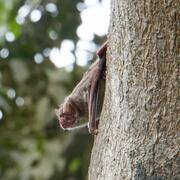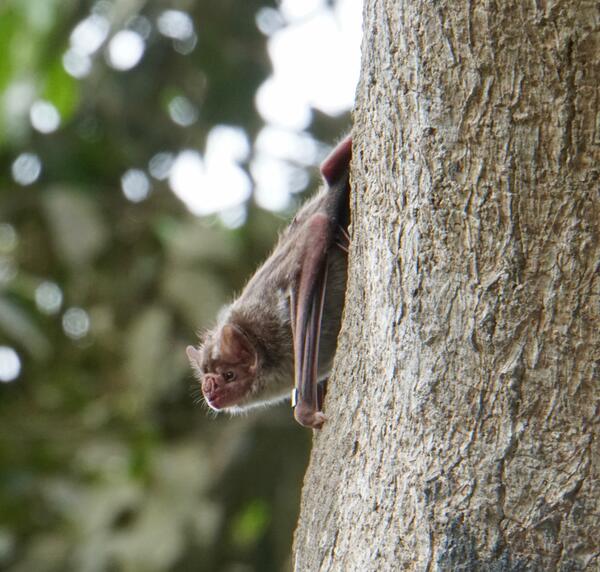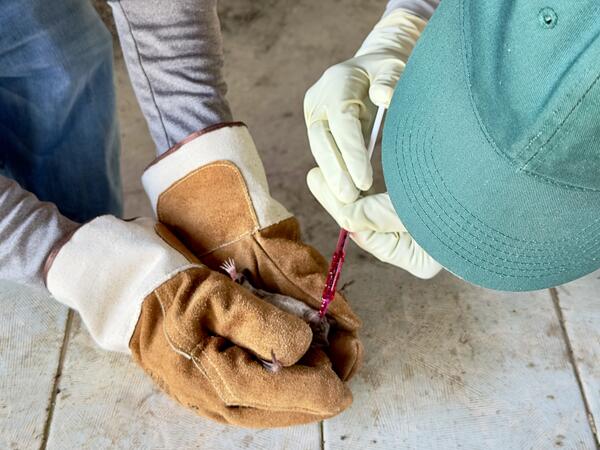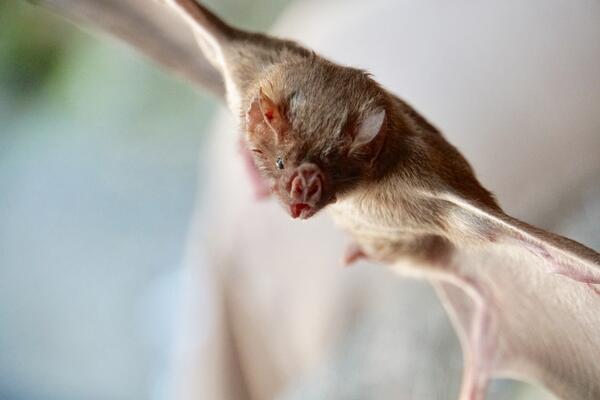USGS is developing and testing a safe rabies vaccine for vampire bats and conducting field studies for a practical delivery of this vaccine to wild populations of bats in the future.
Tonie Rocke
Tonie Rocke is a Research Epidemiologist at the National Wildlife Health Center.
Science and Products
White-nose syndrome vaccine updates
Dynamics of Rabies Transmission in Vampire Bats (Desmodus rotundus) and Potential for Control Through Vaccination
Field trials for testing of white-nose syndrome vaccine candidates
Development of SARS-CoV-2 vaccine to support black-footed ferret conservation
Modeling the response of cave hibernating Myotis species to white-nose syndrome mitigation tactics
Vaccines
Sylvatic Plague
White-Nose Syndrome
Vector-Borne Diseases
Prairie dog trapping locations treated with plague or vaccine baits in western states Prairie dog trapping locations treated with plague or vaccine baits in western states
Little Brown Bats (Myotis lucifugus) weights and Ct values for SARS-CoV-2 Infection challenge Little Brown Bats (Myotis lucifugus) weights and Ct values for SARS-CoV-2 Infection challenge
Temperatures of black-tailed prairie dog burrows through the U.S. Great Plains Temperatures of black-tailed prairie dog burrows through the U.S. Great Plains
Luminescence of AG129 mice infected with recombinant Monkeypox virus expressing firefly luciferase Luminescence of AG129 mice infected with recombinant Monkeypox virus expressing firefly luciferase
Viral loads, histology, and adverse events in transgenic mice after passive transfer of serum from black-footed ferrets (Mustela nigripes) used to assess the anti-viral efficacy of a subunit SARS-CoV-2 vaccine candidate Viral loads, histology, and adverse events in transgenic mice after passive transfer of serum from black-footed ferrets (Mustela nigripes) used to assess the anti-viral efficacy of a subunit SARS-CoV-2 vaccine candidate
Experimental infection of Mexican free-tailed bats (Tadarida brasiliensis) with SARS-CoV-2 Experimental infection of Mexican free-tailed bats (Tadarida brasiliensis) with SARS-CoV-2
In vitro expression, immunogenicity, and efficacy data from recombinant raccoon poxvirus-vectored rabies vaccine candidates tested in mice In vitro expression, immunogenicity, and efficacy data from recombinant raccoon poxvirus-vectored rabies vaccine candidates tested in mice
Data on Flea Parasitism and Annual Re-encounters of Utah Prairie Dogs at 5 colonies on the Awapa Plateau, Utah, USA, 2013-2016 Data on Flea Parasitism and Annual Re-encounters of Utah Prairie Dogs at 5 colonies on the Awapa Plateau, Utah, USA, 2013-2016
Fleas collected from black-tailed prairie dog burrows in 2016 and 2017 Fleas collected from black-tailed prairie dog burrows in 2016 and 2017
Survival of prairie dogs (Cynomys spp.) challenged with Yersina pestis (plague) Survival of prairie dogs (Cynomys spp.) challenged with Yersina pestis (plague)
Sylvatic Plague Vaccine field trials flea data Sylvatic Plague Vaccine field trials flea data
Impact of the oral Sylvatic Plague Vaccine on Non-target Small Rodents: Data Impact of the oral Sylvatic Plague Vaccine on Non-target Small Rodents: Data
USGS is developing and testing a safe rabies vaccine for vampire bats and conducting field studies for a practical delivery of this vaccine to wild populations of bats in the future.
USGS is developing and testing a safe rabies vaccine for vampire bats and conducting field studies for a practical delivery of this vaccine to wild populations of bats in the future.
USGS is developing and testing a safe rabies vaccine for vampire bats and conducting field studies for a practical delivery of this vaccine to wild populations of bats in the future.

Administering the white-nose syndrome vaccine to a bat
Administering the white-nose syndrome vaccine to a batAdministering the white-nose syndrome vaccine to a bat during a field trial.
Administering the white-nose syndrome vaccine to a bat
Administering the white-nose syndrome vaccine to a batAdministering the white-nose syndrome vaccine to a bat during a field trial.
A bat receiving the white-nose syndrome vaccine during a field trial to study vaccine efficacy.
A bat receiving the white-nose syndrome vaccine during a field trial to study vaccine efficacy.
This image shows the blue version of sylvatic plague vaccine bait for prairie dogs.
Prairie dogs in the wild are less likely to succumb to a deadly disease called sylvatic plague after they ingest peanut-butter-flavored bait that contains a vaccine against the disease.
This image shows the blue version of sylvatic plague vaccine bait for prairie dogs.
Prairie dogs in the wild are less likely to succumb to a deadly disease called sylvatic plague after they ingest peanut-butter-flavored bait that contains a vaccine against the disease.
Vampire bats (Desmodus rotundus) are the primary spreader of rabies, a lethal disease that harms livestock and people across Latin America, where this bat lives.
Vampire bats (Desmodus rotundus) are the primary spreader of rabies, a lethal disease that harms livestock and people across Latin America, where this bat lives.
An endangered black-footed ferret is released on private land in Arizona as part of a collaborative species recovery effort.
An endangered black-footed ferret is released on private land in Arizona as part of a collaborative species recovery effort.
In this image, a Gunnison prairie dog eats a bait laden with the sylvatic plague vaccine. Prairie dogs in the wild are less likely to succumb to plague after they ingest peanut-butter-flavored bait that contains a vaccine against the disease.
In this image, a Gunnison prairie dog eats a bait laden with the sylvatic plague vaccine. Prairie dogs in the wild are less likely to succumb to plague after they ingest peanut-butter-flavored bait that contains a vaccine against the disease.
Safety and immunogenicity of poultry vaccine for protecting critically endangered avian species against highly pathogenic avian influenza virus, United States Safety and immunogenicity of poultry vaccine for protecting critically endangered avian species against highly pathogenic avian influenza virus, United States
Vaccination of endangered wildlife as a conservation tool: Hindsights and new horizons in the pandemic era Vaccination of endangered wildlife as a conservation tool: Hindsights and new horizons in the pandemic era
Density estimation using spatial capture-recapture analyses: Application to vaccination of prairie dogs against sylvatic plague Density estimation using spatial capture-recapture analyses: Application to vaccination of prairie dogs against sylvatic plague
Little brown bats (Myotis lucifugus) are resistant to SARS-CoV-2 infection Little brown bats (Myotis lucifugus) are resistant to SARS-CoV-2 infection
Developing transmissible vaccines for animal infections Developing transmissible vaccines for animal infections
Prairie dog responses to vector control and vaccination during an initial Yersinia pestis invasion Prairie dog responses to vector control and vaccination during an initial Yersinia pestis invasion
Incorporating environmental heterogeneity and observation effort to predict host distribution and viral spillover from a bat reservoir Incorporating environmental heterogeneity and observation effort to predict host distribution and viral spillover from a bat reservoir
Managing an ongoing threat: Bats and white-nose syndrome Managing an ongoing threat: Bats and white-nose syndrome
Management of vampire bats and rabies: Past, present, and future Management of vampire bats and rabies: Past, present, and future
Monkeypox virus in animals: Current knowledge of viral transmission and pathogenesis in wild animal reservoirs and captive animal models Monkeypox virus in animals: Current knowledge of viral transmission and pathogenesis in wild animal reservoirs and captive animal models
Sex-biased infections scale to population impacts for an emerging wildlife disease Sex-biased infections scale to population impacts for an emerging wildlife disease
Experimental infection of Mexican free-tailed bats (Tadarida brasiliensis) with SARS-CoV-2 Experimental infection of Mexican free-tailed bats (Tadarida brasiliensis) with SARS-CoV-2
Science and Products
White-nose syndrome vaccine updates
Dynamics of Rabies Transmission in Vampire Bats (Desmodus rotundus) and Potential for Control Through Vaccination
Field trials for testing of white-nose syndrome vaccine candidates
Development of SARS-CoV-2 vaccine to support black-footed ferret conservation
Modeling the response of cave hibernating Myotis species to white-nose syndrome mitigation tactics
Vaccines
Sylvatic Plague
White-Nose Syndrome
Vector-Borne Diseases
Prairie dog trapping locations treated with plague or vaccine baits in western states Prairie dog trapping locations treated with plague or vaccine baits in western states
Little Brown Bats (Myotis lucifugus) weights and Ct values for SARS-CoV-2 Infection challenge Little Brown Bats (Myotis lucifugus) weights and Ct values for SARS-CoV-2 Infection challenge
Temperatures of black-tailed prairie dog burrows through the U.S. Great Plains Temperatures of black-tailed prairie dog burrows through the U.S. Great Plains
Luminescence of AG129 mice infected with recombinant Monkeypox virus expressing firefly luciferase Luminescence of AG129 mice infected with recombinant Monkeypox virus expressing firefly luciferase
Viral loads, histology, and adverse events in transgenic mice after passive transfer of serum from black-footed ferrets (Mustela nigripes) used to assess the anti-viral efficacy of a subunit SARS-CoV-2 vaccine candidate Viral loads, histology, and adverse events in transgenic mice after passive transfer of serum from black-footed ferrets (Mustela nigripes) used to assess the anti-viral efficacy of a subunit SARS-CoV-2 vaccine candidate
Experimental infection of Mexican free-tailed bats (Tadarida brasiliensis) with SARS-CoV-2 Experimental infection of Mexican free-tailed bats (Tadarida brasiliensis) with SARS-CoV-2
In vitro expression, immunogenicity, and efficacy data from recombinant raccoon poxvirus-vectored rabies vaccine candidates tested in mice In vitro expression, immunogenicity, and efficacy data from recombinant raccoon poxvirus-vectored rabies vaccine candidates tested in mice
Data on Flea Parasitism and Annual Re-encounters of Utah Prairie Dogs at 5 colonies on the Awapa Plateau, Utah, USA, 2013-2016 Data on Flea Parasitism and Annual Re-encounters of Utah Prairie Dogs at 5 colonies on the Awapa Plateau, Utah, USA, 2013-2016
Fleas collected from black-tailed prairie dog burrows in 2016 and 2017 Fleas collected from black-tailed prairie dog burrows in 2016 and 2017
Survival of prairie dogs (Cynomys spp.) challenged with Yersina pestis (plague) Survival of prairie dogs (Cynomys spp.) challenged with Yersina pestis (plague)
Sylvatic Plague Vaccine field trials flea data Sylvatic Plague Vaccine field trials flea data
Impact of the oral Sylvatic Plague Vaccine on Non-target Small Rodents: Data Impact of the oral Sylvatic Plague Vaccine on Non-target Small Rodents: Data
USGS is developing and testing a safe rabies vaccine for vampire bats and conducting field studies for a practical delivery of this vaccine to wild populations of bats in the future.
USGS is developing and testing a safe rabies vaccine for vampire bats and conducting field studies for a practical delivery of this vaccine to wild populations of bats in the future.
USGS is developing and testing a safe rabies vaccine for vampire bats and conducting field studies for a practical delivery of this vaccine to wild populations of bats in the future.
USGS is developing and testing a safe rabies vaccine for vampire bats and conducting field studies for a practical delivery of this vaccine to wild populations of bats in the future.

Administering the white-nose syndrome vaccine to a bat
Administering the white-nose syndrome vaccine to a batAdministering the white-nose syndrome vaccine to a bat during a field trial.
Administering the white-nose syndrome vaccine to a bat
Administering the white-nose syndrome vaccine to a batAdministering the white-nose syndrome vaccine to a bat during a field trial.
A bat receiving the white-nose syndrome vaccine during a field trial to study vaccine efficacy.
A bat receiving the white-nose syndrome vaccine during a field trial to study vaccine efficacy.
This image shows the blue version of sylvatic plague vaccine bait for prairie dogs.
Prairie dogs in the wild are less likely to succumb to a deadly disease called sylvatic plague after they ingest peanut-butter-flavored bait that contains a vaccine against the disease.
This image shows the blue version of sylvatic plague vaccine bait for prairie dogs.
Prairie dogs in the wild are less likely to succumb to a deadly disease called sylvatic plague after they ingest peanut-butter-flavored bait that contains a vaccine against the disease.
Vampire bats (Desmodus rotundus) are the primary spreader of rabies, a lethal disease that harms livestock and people across Latin America, where this bat lives.
Vampire bats (Desmodus rotundus) are the primary spreader of rabies, a lethal disease that harms livestock and people across Latin America, where this bat lives.
An endangered black-footed ferret is released on private land in Arizona as part of a collaborative species recovery effort.
An endangered black-footed ferret is released on private land in Arizona as part of a collaborative species recovery effort.
In this image, a Gunnison prairie dog eats a bait laden with the sylvatic plague vaccine. Prairie dogs in the wild are less likely to succumb to plague after they ingest peanut-butter-flavored bait that contains a vaccine against the disease.
In this image, a Gunnison prairie dog eats a bait laden with the sylvatic plague vaccine. Prairie dogs in the wild are less likely to succumb to plague after they ingest peanut-butter-flavored bait that contains a vaccine against the disease.

















